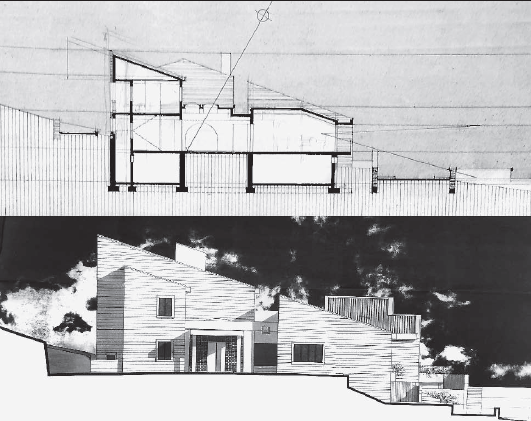Tito's Residential Complex in Miločer, Budva (1975-1980)
From Vernacular to Regional Architectural Practice
DOI:
https://doi.org/10.31522/p.32.1(67).4Keywords:
Miločer, Budva, Montenegro, regionalism, state-residence, Tito, Josip BrozAbstract
The subject of this paper is the development of a conceptual design proposal for the official residence for the President of Yugoslavia Josip Broz Tito on the Adriatic coast of Miločer, Budva (1975-1980). The research aims to unveil patterns of the regionalist approach within urban and architectural thought in the Socialist Republic of Montenegro (SR Montenegro) through the project of the presidential complex, shown here for the first time since its official presentation to the president himself in 1976. In methodological terms, the paper examines multiple layers of historical background of Miločer that affected the designers' process of thinking, followed by a clear-cut description of the planning procedures, methodologies and reasoning that emerged from the archives and the first-hand witnesses of the whole process. The final results reflect on the critical approach within the practice of the post-war generation of Montenegrin architects, successfully balancing between the poles of power-representation and contemporary architectural currents.
References
Avermaete, T., (2004) 'Travelling Notions of Public and Private: The French Mass Tourism Projects of Candilis-Josic-Woods', OASE, 64, pp. 16-45. Available at: https://www.oasejournal.nl/en/Issues/64/TravellingNotionsOfPublicAndPrivate#016 [Accessed: 20 February 2024].
Avermaete, T., (2006) 'Mat-building - Team 10’s reinvention of the critical capacity of the urban tissue'. In: Risselada, M.; Heuvel, D. van den and Frampton, K. eds., Team 10 in search of a Utopia of the present, 1953-81. Rotterdam: Nai Publishers, pp. 307-312.
Aymonino, C. (1970) ‘Consuntivo di un’esperienza di progettazione: Dialogo con i protagonisti’, L’Architettura: Cronache e storia, 175, 18-19.
Banham, R. (1976), Megastructure: urban futures and recent past. London: Thames and Hudson.
Bernik, S. (2002), Zlatko Ugljen Arhitekt. Tuzla: Međunarodna Galerija Portreta Tuzla.
Broz, T., (1959) Govori i članci. Zagreb: Naprijed.
Bulatović, D., (2022) "Revisiting the Yugoslav Florida: Decoding the heritage of leisure architecture on the Montenegrin coastline." Master of Art, University of Westminster.
Grabrijan, D., Neidhardt, J., (1957), Arhitektura Bosne i put u suvremeno. Sarajevo: Državna založba Slovenije.
Karač, Z. and Premović, G. (2021) 'Arhitektura i kontekst u konceptu turističkog naselja „Slovenska plaža”', Anali za istrske in mediteranske študije, Volume 31 (4), pp.634-657.
Keković, A., Petrović, M. and Ćurčić, A., (2019) 'The Paštrovska House of the Montenegrin Coastal Area: Example of Sustainable Building in Traditional Architecture', Technical Gazette, 26 (3), pp. 686–687. https://doi.org/10.17559/TV-20180910230243
Kojić, B. (1964) ‘L’architecture rurale de Boka Kotorska' in Merin, O. (ed.) Le Monténégro. Ljubljana: Ljudska Pravica.
Kulić, V. (2009) Land of the In-Between: Modern Architecture and the State in Socialist Yugoslavia, 1945-65, PhD thesis, Faculty of the Graduate School of The University of Texas.
Kulić, V. (2014) ‘Building the Non-Aligned Babel: Babylon Hotel in Baghdad and Mobile Design in the Global Cold War', ABE Journal 6 | 2014 [Online]. Available at: https://doi.org/10.4000/abe.924 [Accessed: 16 02 2024].
Lajović, V., (2015) ‘Sveti Stefan – od Kardelja do Statisa’, Vijesti, Available at: https://www.vijesti.me/vijesti/ekonomija/172466/sveti-stefan-od-kardelja-i-tita-do-statisa [Accessed: 15 April 2024].
Markuš, A. (2008), 50 Neimara Crne Gore. Podgorica: Arhitektonski Forum.
Martinović, N. (ed.) (2021), Leksikon likovne umjetnosti Crne Gore, Podgorica, CANU.
Minić, O. (ed.) (1965) “Rezultati konkursa za izradu idejnog urbanističko-arhitektonskog rešenja turističkog područja Sveti Stefan – Miločer – Pržno“, Arhitektura Urbanizam, 33-34, pp.65-66.
Niebyl, D., (2020) Examining the 34 Villas of Yugoslav President Josip Broz Tito [online]. Available at: https://www.spomenikdatabase.org/post/examining-the-34-villas-of-yugoslav-president-josip-broz-tito [Accessed: 15 02 2024].
Radulović, V., Alihodžić Jašarović, E., Žarić, S., (2020) ‘Tito’s Villas in Herceg Novi – Regional Contexts and State Residences', Architektúra & urbanizmus, 55(1-2), pp. 60-75. Available at: https://doi.org/10.31577/archandurb.2021.55.1-2.5 [Accessed at: 20 February 2024].
Savorra, M., (2018) ‘Leisure in Time of Utopia’, in Donetti, D. (ed.) Architecture and Dystopia. New York: Actar Publishers, pp. 129-231.
Stamatović, Vučković, S. (2023). Arhitektura u Crnoj Gori u XIX I XX vijeku – Period 1945 - 2000, u: Čilikov, A., Pejović, L. (eds.) Istorija umjetnosti Crne Gore - Umjetnost Crne Gore od sredine XIX do početka XXI vijeka, Vol. 3, Podgorica: CANU – Crnogorska akademija nauka i umjetnosti, pp 59–126.
Šentija, J., (1982), Enciklopedija Jugoslavije, Zagreb: JLZ.
Vodopivec, A. and Žnidaršič, R. (eds.) (2010) Edvard Ravnikar: Architect and Teacher. Vienna: Springer-Verlag. https://doi.org/10.1007/978-3-211-99204-3
Zloković, M. (1964), ‘Maison et Palais' in Merin, O. (ed.) Le Monténégro. Ljubljana: Ljudska Pravica.
Đ., Z. (1963) ‘Sveti Stefan – grad-hotel’, Arhitektura Urbanizam, 22/23, pp. 42-43.

Downloads
Published
How to Cite
Issue
Section
License
Copyright (c) 2024 Danilo Bulatović

This work is licensed under a Creative Commons Attribution 4.0 International License.
Copyright (c) 2021 authors and journal.
This work is licensed under a Creative Commons Attribution 4.0 International License.
Authors who publish with this journal agree to the following terms:
In agreeing this form, you certify that:
- You read the ethical codex of the PROSTOR available at journal web.
- You submitted work is your original work, and has not previously been published and does not include any form of plagiarism.
- You own copyright in the submitted work, and are therefore permitted to assign the licence to publish to PROSTOR.
- Your submitted work contains no violation of any existing copyright or other third party right or any material of an obscene, libellous or otherwise unlawful nature.
- You have obtained permission for and acknowledged the source of any illustrations, diagrams or other material included in the work of which you are not the copyright owner.
- You have taken due care to ensure the accuracy of the work, and that, to the best of your knowledge, there are no false statements made within it.
- All co-authors of this submitted work are aware of, and in agreement with, the terms of this licence and that the submitted manuscript has been approved by these authors.






